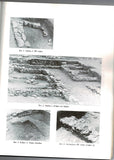Manika II: The early Helladic settlement and cemetery
Author: Adamantios A Sampson (1944- ) Inscribed
Year: 1988
Publisher: Hetaireia Euboïkon Spudōn, Tmēma Chalkidos
Place: Athens
Description:
214+[32 plate]+[1 folding map] pages with charts, figures, tables, illustrations, drawings, maps and appendices. Quarto (11" x 8 1/4") bound in original publisher's pictorial wrappers. Inscribed by the author. First edition.
For many years it has commonly been accepted that the prehistoric settlement of Manika occupied the entire peninsula of the same name five kilometers north of Chalcis at Euboea. A part of the settlement’s cemetery was excavated in 1904, but, until recently, the location of the settlement itself had not been identified. The excavations of 1982 were carried out far from the peninsula in three distant spots (see map). These uncovered well-preserved Early Helladic buildings (at a depth of 0,20 m), private dwellings and a workshop. The surface prospection in the excavated areas also located buildings of the same period and thus the existence of an early Bronze Age town extending on at least 200-250 acres beyond the peninsula was proven. The expansion of the town was probably due to the maritime, commercial and technical activities of its inhabitants. Furthermore, 21 vaulted tombs have been recently excavated in the area. They were carved in the hard rock and they are similar to the tombs excavated in 1904. The cemetery of Manika covers a wide are and dates back to the early part of Early Helladic II and also to the last part of the Early Helladic III period. The tombs are water-tight and display human skeletons in cross-legged positions and a number of burial offerings, most of them originating from the Cyclades and the East. There are imported vessels, products of exchange in the Aegean area. The tombs of the rich are distinguished from those of the poor by their construction and the quality of offerings they contain. Most of the vessels found in the tombs are absent from the settlement. This can be either incidental or due to the burial customs dictating that only precious, imported vessels could serve as offerings. However, the tombs are monumental and prove, in a way, the prosperity of the inhabitants of the settlement, that flourished during the Early Helladic II period. The Helladic character of the settlement and the cemetery of Manika is clear although the relation held with the Aegean and the East are obvious. After the recent archaeological finds, the theory that Manika could have been a Cycladic colony no longer seems to be correct. Manika was an important settlement through which bronze and obsidian was imported to Euboea, Boeotia and probably to Thessaly. The Neolithic settlements of Euboea were communicating with the Aegean area from the 4th millennium BC. The civilization of Euboea in the Early Helladic II period can be considered as the successor of the culture of Attica – Euboea Kephala, a part of the wider Aegean civilization of the last Neolithic age.
Condition:
Inscribed by the author on the front end paper. Spine sunned, corners bumped and rubbed else very good.















